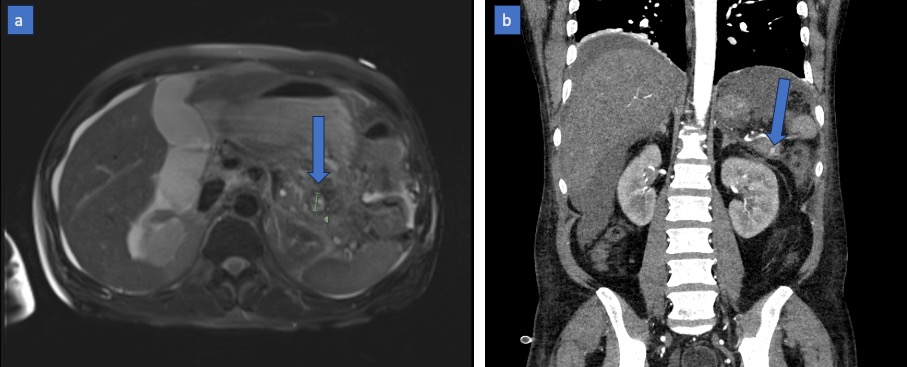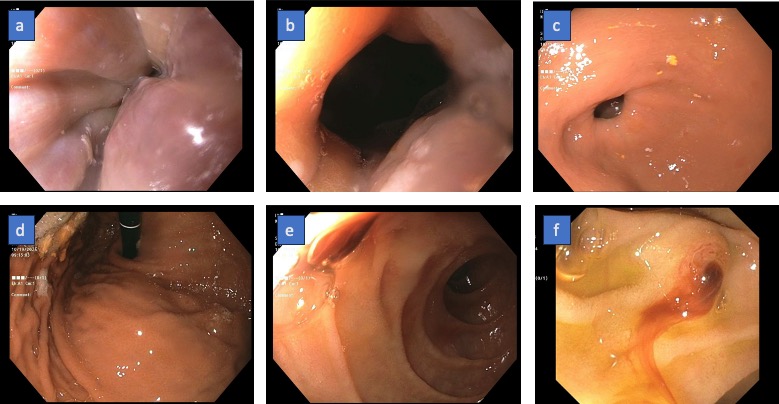Tuesday Poster Session
Category: Biliary/Pancreas
P4531 - A Rare Case of Hemosuccus Pancreaticus Secondary to Hemorrhagic Pancreatitis
Tuesday, October 28, 2025
10:30 AM - 4:00 PM PDT
Location: Exhibit Hall

Muhammad Ibrahim Majeed, MBBS (he/him/his)
Corewell Health William Beaumont University Hospital
Royal Oak, MI
Presenting Author(s)
Muhammad Ibrahim Majeed, MD1, Nishant Aggarwal, MD1, Fady Banno, MD1, Mohamed Abdallah, MD2, Wael Dahhan, MD1, Mohammad Adam, MD, MSc3, Ali Osman, MD, MSCI Candidate4, Thuraya Mussa, MD5
1Corewell Health William Beaumont University Hospital, Royal Oak, MI; 2Corewell Health, Royal Oak, MI; 3University of Missouri - Kansas City School of Medicine, Kansas City, MO; 4Washington University School of Medicine in St. Louis, Ballwin, MO; 5Michigan State University, Lansing, MI
Introduction: Hemosuccus pancreaticus (HP) is a rare cause of upper gastrointestinal bleeding (UGIB), defined as bleeding from the ampulla of Vater via the pancreatic duct. It occurs in 1 in 1500 UGIB cases and is usually seen with chronic pancreatitis-related pseudoaneurysms, pancreatic neoplasms, or trauma. We present a case of HP likely secondary to hemorrhagic pancreatitis, without the usual etiologies.
Case Description/
Methods: A 52-year-old male with alcohol use disorder and chronic pancreatitis was admitted for altered mental status and found to have severe alcohol-related hepatitis in the setting of decompensated cirrhosis. He reported melena and epigastric pain; vitals showed mild tachycardia and systolic blood pressure of 96 mmHg. Investigations showed hemoglobin 7.7 g/dL (baseline 9–10), lipase 24 U/L, AST 130 U/L, ALT 69 U/L, ALP 87 U/L, total bilirubin 22.2 mg/dL (direct >15), undetectable fecal elastase, and phosphatidylethanol >2000 ng/mL. He was started on intravenous pantoprazole.
Esophageogastroduodenoscopy (EGD) revealed slow oozing at the papilla clearly originating from the pancreatic orifice as bile was seen flowing from biliary orifice, confirmed via duodenoscopy (figure 1). Non-bleeding grade II esophageal varices were also noted and not banded. CT angiography showed distal pancreatitis with a 6 mm hyperenhancing lesion in the pancreatic tail on arterial phase (figure 2). Given concern for pseudoaneurysm, invasive angiography was performed but showed no active bleed or pseudoaneurysm. Magnetic Resonance Cholangiopancreatography (MRCP) confirmed the CT findings, showing multiple small hemorrhagic foci in the distal pancreatic tail, suggesting hemorrhagic pancreatitis. The bleeding was thought to be secondary to a small fistulous tract between the hemorrhagic foci and pancreatic duct. The patient was managed conservatively with resolution of melena. At follow-up, he reported continued alcohol abstinence and clinical improvement.
Discussion: Hemorrhagic pancreatitis stems from enzymatic extravasation and erosion of local vessels, leading to UGIB. Although melena with heavy alcohol use is often due to peptic ulcer or portal hypertensive bleeding, rare cases can include HP due to hemorrhagic pancreatitis, especially when no clear source is found on EGD. A high index of suspicion and early use of CT angiogram and MRCP can aid in early diagnosis and appropriate management. Angiographic embolization may be needed to prevent complications such as hemorrhagic shock and multi-organ failure.

Figure: Figure 1: EGD findings showing (a) Lower Esophagus with non-bleeding grade II esophageal varices, (b) GEJ (c) Gastric Antrum/Pylorus (d) Gastric Fundus (e) 2nd part of duodenum with suspected HP (f) Pancreatic papilla with active oozing visualized using duodenoscope.

Figure: Figure 2: CT angiography with 6 mm hyperenhancing lesion seen in the pancreatic tail on arterial phase (a) Axial view (b) Coronal view.
Disclosures:
Muhammad Ibrahim Majeed indicated no relevant financial relationships.
Nishant Aggarwal indicated no relevant financial relationships.
Fady Banno indicated no relevant financial relationships.
Mohamed Abdallah indicated no relevant financial relationships.
Wael Dahhan indicated no relevant financial relationships.
Mohammad Adam indicated no relevant financial relationships.
Ali Osman indicated no relevant financial relationships.
Thuraya Mussa indicated no relevant financial relationships.
Muhammad Ibrahim Majeed, MD1, Nishant Aggarwal, MD1, Fady Banno, MD1, Mohamed Abdallah, MD2, Wael Dahhan, MD1, Mohammad Adam, MD, MSc3, Ali Osman, MD, MSCI Candidate4, Thuraya Mussa, MD5. P4531 - A Rare Case of Hemosuccus Pancreaticus Secondary to Hemorrhagic Pancreatitis, ACG 2025 Annual Scientific Meeting Abstracts. Phoenix, AZ: American College of Gastroenterology.
1Corewell Health William Beaumont University Hospital, Royal Oak, MI; 2Corewell Health, Royal Oak, MI; 3University of Missouri - Kansas City School of Medicine, Kansas City, MO; 4Washington University School of Medicine in St. Louis, Ballwin, MO; 5Michigan State University, Lansing, MI
Introduction: Hemosuccus pancreaticus (HP) is a rare cause of upper gastrointestinal bleeding (UGIB), defined as bleeding from the ampulla of Vater via the pancreatic duct. It occurs in 1 in 1500 UGIB cases and is usually seen with chronic pancreatitis-related pseudoaneurysms, pancreatic neoplasms, or trauma. We present a case of HP likely secondary to hemorrhagic pancreatitis, without the usual etiologies.
Case Description/
Methods: A 52-year-old male with alcohol use disorder and chronic pancreatitis was admitted for altered mental status and found to have severe alcohol-related hepatitis in the setting of decompensated cirrhosis. He reported melena and epigastric pain; vitals showed mild tachycardia and systolic blood pressure of 96 mmHg. Investigations showed hemoglobin 7.7 g/dL (baseline 9–10), lipase 24 U/L, AST 130 U/L, ALT 69 U/L, ALP 87 U/L, total bilirubin 22.2 mg/dL (direct >15), undetectable fecal elastase, and phosphatidylethanol >2000 ng/mL. He was started on intravenous pantoprazole.
Esophageogastroduodenoscopy (EGD) revealed slow oozing at the papilla clearly originating from the pancreatic orifice as bile was seen flowing from biliary orifice, confirmed via duodenoscopy (figure 1). Non-bleeding grade II esophageal varices were also noted and not banded. CT angiography showed distal pancreatitis with a 6 mm hyperenhancing lesion in the pancreatic tail on arterial phase (figure 2). Given concern for pseudoaneurysm, invasive angiography was performed but showed no active bleed or pseudoaneurysm. Magnetic Resonance Cholangiopancreatography (MRCP) confirmed the CT findings, showing multiple small hemorrhagic foci in the distal pancreatic tail, suggesting hemorrhagic pancreatitis. The bleeding was thought to be secondary to a small fistulous tract between the hemorrhagic foci and pancreatic duct. The patient was managed conservatively with resolution of melena. At follow-up, he reported continued alcohol abstinence and clinical improvement.
Discussion: Hemorrhagic pancreatitis stems from enzymatic extravasation and erosion of local vessels, leading to UGIB. Although melena with heavy alcohol use is often due to peptic ulcer or portal hypertensive bleeding, rare cases can include HP due to hemorrhagic pancreatitis, especially when no clear source is found on EGD. A high index of suspicion and early use of CT angiogram and MRCP can aid in early diagnosis and appropriate management. Angiographic embolization may be needed to prevent complications such as hemorrhagic shock and multi-organ failure.

Figure: Figure 1: EGD findings showing (a) Lower Esophagus with non-bleeding grade II esophageal varices, (b) GEJ (c) Gastric Antrum/Pylorus (d) Gastric Fundus (e) 2nd part of duodenum with suspected HP (f) Pancreatic papilla with active oozing visualized using duodenoscope.

Figure: Figure 2: CT angiography with 6 mm hyperenhancing lesion seen in the pancreatic tail on arterial phase (a) Axial view (b) Coronal view.
Disclosures:
Muhammad Ibrahim Majeed indicated no relevant financial relationships.
Nishant Aggarwal indicated no relevant financial relationships.
Fady Banno indicated no relevant financial relationships.
Mohamed Abdallah indicated no relevant financial relationships.
Wael Dahhan indicated no relevant financial relationships.
Mohammad Adam indicated no relevant financial relationships.
Ali Osman indicated no relevant financial relationships.
Thuraya Mussa indicated no relevant financial relationships.
Muhammad Ibrahim Majeed, MD1, Nishant Aggarwal, MD1, Fady Banno, MD1, Mohamed Abdallah, MD2, Wael Dahhan, MD1, Mohammad Adam, MD, MSc3, Ali Osman, MD, MSCI Candidate4, Thuraya Mussa, MD5. P4531 - A Rare Case of Hemosuccus Pancreaticus Secondary to Hemorrhagic Pancreatitis, ACG 2025 Annual Scientific Meeting Abstracts. Phoenix, AZ: American College of Gastroenterology.
